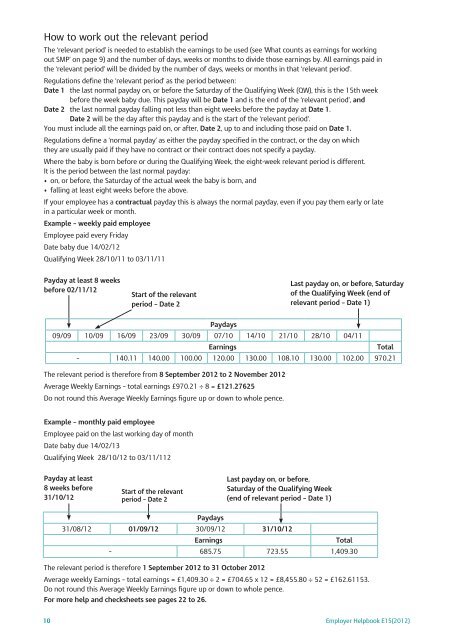Employer Helpbook for Statutory Maternity Pay - HM Revenue ...
Employer Helpbook for Statutory Maternity Pay - HM Revenue ...
Employer Helpbook for Statutory Maternity Pay - HM Revenue ...
Create successful ePaper yourself
Turn your PDF publications into a flip-book with our unique Google optimized e-Paper software.
How to work out the relevant period<br />
The ‘relevant period’ is needed to establish the earnings to be used (see 'What counts as earnings <strong>for</strong> working<br />
out SMP’ on page 9) and the number of days, weeks or months to divide those earnings by. All earnings paid in<br />
the ‘relevant period’ will be divided by the number of days, weeks or months in that ‘relevant period’.<br />
Regulations define the ‘relevant period’ as the period between:<br />
Date 1 the last normal payday on, or be<strong>for</strong>e the Saturday of the Qualifying Week (QW), this is the 15th week<br />
be<strong>for</strong>e the week baby due. This payday will be Date 1 and is the end of the ‘relevant period’, and<br />
Date 2 the last normal payday falling not less than eight weeks be<strong>for</strong>e the payday at Date 1.<br />
Date 2 will be the day after this payday and is the start of the ‘relevant period’.<br />
You must include all the earnings paid on, or after, Date 2, up to and including those paid on Date 1.<br />
Regulations define a ‘normal payday’ as either the payday specified in the contract, or the day on which<br />
they are usually paid if they have no contract or their contract does not specify a payday.<br />
Where the baby is born be<strong>for</strong>e or during the Qualifying Week, the eight-week relevant period is different.<br />
It is the period between the last normal payday:<br />
• on, or be<strong>for</strong>e, the Saturday of the actual week the baby is born, and<br />
• falling at least eight weeks be<strong>for</strong>e the above.<br />
If your employee has a contractual payday this is always the normal payday, even if you pay them early or late<br />
in a particular week or month.<br />
Example – weekly paid employee<br />
Employee paid every Friday<br />
Date baby due 14/02/12<br />
Qualifying Week 28/10/11 to 03/11/11<br />
<strong>Pay</strong>day at least 8 weeks<br />
be<strong>for</strong>e 02/11/12<br />
Start of the relevant<br />
period – Date 2<br />
The relevant period is there<strong>for</strong>e from 8 September 2012 to 2 November 2012<br />
Average Weekly Earnings – total earnings £970.21 ÷ 8 = £121.27625<br />
Do not round this Average Weekly Earnings figure up or down to whole pence.<br />
Example – monthly paid employee<br />
Employee paid on the last working day of month<br />
Date baby due 14/02/13<br />
Qualifying Week 28/10/12 to 03/11/112<br />
<strong>Pay</strong>day at least<br />
8 weeks be<strong>for</strong>e<br />
31/10/12<br />
Start of the relevant<br />
period – Date 2<br />
The relevant period is there<strong>for</strong>e 1 September 2012 to 31 October 2012<br />
Last payday on, or be<strong>for</strong>e, Saturday<br />
of the Qualifying Week (end of<br />
relevant period – Date 1)<br />
Average weekly Earnings – total earnings = £1,409.30 ÷ 2 = £704.65 x 12 = £8,455.80 ÷ 52 = £162.61153.<br />
Do not round this Average Weekly Earnings figure up or down to whole pence.<br />
For more help and checksheets see pages 22 to 26.<br />
10<br />
<strong>Pay</strong>days<br />
09/09 10/09 16/09 23/09 30/09 07/10 14/10 21/10 28/10 04/11<br />
Earnings Total<br />
– 140.11 140.00 100.00 120.00 130.00 108.10 130.00 102.00 970.21<br />
<strong>Pay</strong>days<br />
Last payday on, or be<strong>for</strong>e,<br />
Saturday of the Qualifying Week<br />
(end of relevant period – Date 1)<br />
31/08/12 01/09/12 30/09/12 31/10/12<br />
Earnings Total<br />
– 685.75 723.55 1,409.30<br />
<strong>Employer</strong> <strong>Helpbook</strong> E15(2012)

















